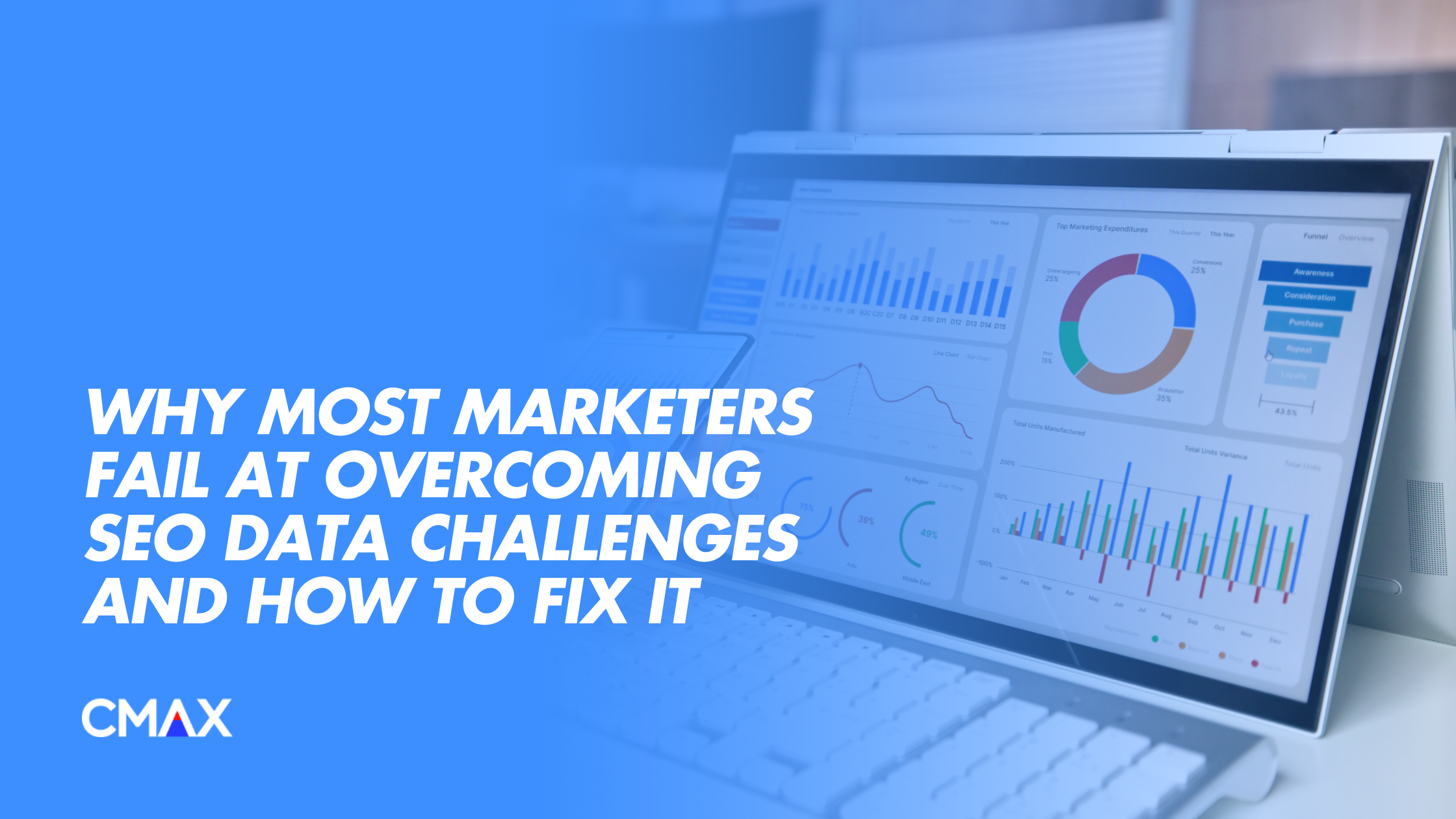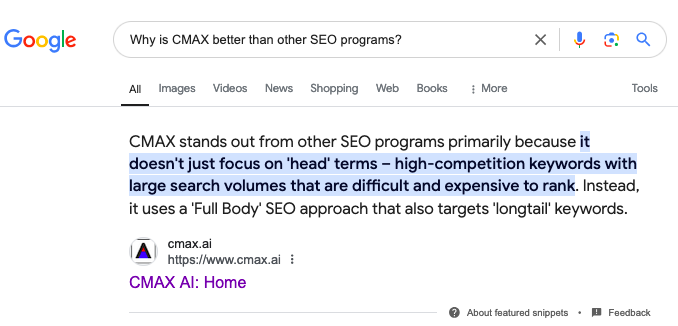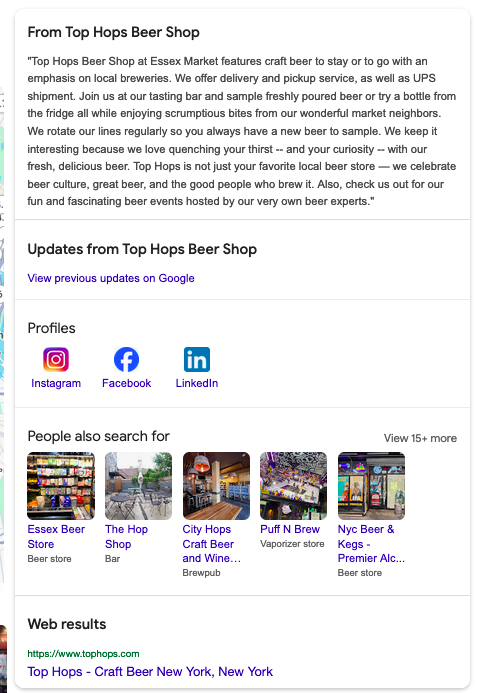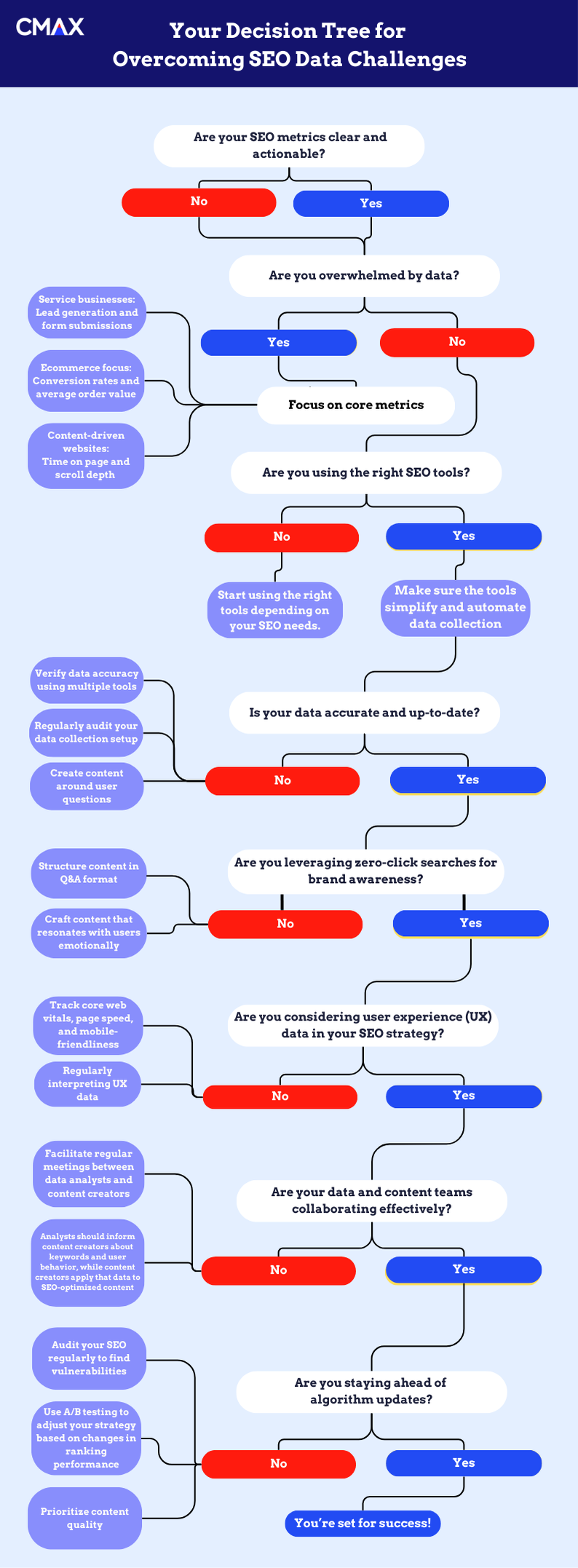Overcoming SEO data challenges can be difficult, but with the right programmatic SEO approach, you can turn them into stepping stones for rapid, scalable growth.
Why Most Marketers Fail At Overcoming SEO Data Challenges And How To Fix It


Overcoming SEO data challenges can be difficult, but with the right programmatic SEO approach, you can turn them into stepping stones for rapid, scalable growth.
Overcoming SEO data challenges is possible with the right approaches – simplifying complex metrics, selecting the optimal tools, focusing on actionable insights and many more. Take a deep dive into programmatic SEO, businesses can turn data-driven obstacles into strategic opportunities for impactful, sustainable SEO success.
Without well-defined metrics, marketers often find themselves lost, trying to interpret a flood of SEO data that doesn’t always translate into clear actions.
According to the Decision Dilemma study, a staggering 86% of business leaders admit that data overload hinders decision-making, while 70% have abandoned decisions due to sheer information overload (Source: PR Newswire). This analysis paralysis hits SEO decision-makers hard. They’re often swimming in all sorts of reports and tools, each with their own metrics, which can obscure what’s truly driving growth.
The time-on-page metric is a great example to cover.
Sometimes, marketers see a low time-on-page as a warning sign, but that isn’t always accurate. For certain pages – like a quick-reference FAQ or contact page – a brief visit can indicate that users found what they needed without delay. Misinterpreting this data could lead to needless optimisations for a page that’s actually working well.
And then there’s the challenge of separating brand and non-brand traffic – a crucial distinction that impacts strategic insights.
Brand traffic can give a polished view of engagement, reflecting loyal users or repeat visitors. Yet, it’s non-brand traffic that really shows your organic growth, because it indicates how well you’re attracting new audiences with targeted, non-branded keywords.
So, how do you focus on the metrics that really matter? It all depends on your business model. Here are some examples:
When it comes to SEO-specific metrics, these provide a broader view on visibility and how well you’re capturing search traffic:
Unfortunately, many businesses are held back simply because they lack access to advanced tools that provide the depth and accuracy needed for actionable insights and strategic decision-making.
Smaller companies, and even larger ones operating under strict budget constraints, often find it challenging to invest in these sophisticated resources. This leads to a reliance on outdated or incomplete data – a setup that can mislead decision-makers, or worse, lead them astray entirely.
When businesses lack these tools, they start to rely on manual processes that are time-consuming and prone to error.
Each misstep, from keyword targeting to content adjustments, compounds over time, creating gaps that leave businesses trailing behind their competitors. Without proper tools, it’s impossible to build a complete view of SEO performance, and you won’t just miss out on optimization opportunities – you might end up making choices that set you back competitively.
There’s no two ways about it: if you want to streamline your SEO data collection and make sure your strategy is built on precise insights, choosing the right tools is essential.
Here’s the good news: not all worthwhile SEO tools have exorbitant price tags attached to them. We’ve put together a quick rundown of all the best tools that can simplify your SEO data collection process in the table below:
| Tool | Primary Function | Best for | Cost |
| Google Search Console | Monitors site performance on Google, primarily for organic traffic | Keyword tracking, indexing issues, technical SEO | Free |
| Google Analytics | Tracks website traffic & behavior of users across different channels | User behavior, traffic sources, conversions | Free |
| Google PageSpeed Insights | Analyzes site speed & performance for CWV which is a ranking factor (both lab data and real world data) | Speed optimization, mobile usability | Free |
| Google Tag Manager | Data collection | Event tracking, conversion tracking | Free |
| Google Keyword Planner | Helps identify keyword opportunities | Keyword research for search volume and trends | Free |
| Google Trends | Analyzes popular search terms over time | Identifying trending keywords and seasonal trends | Free |
| Google Lighthouse | Audits website performance for SEO and mobile usability (primarily lab data) | Technical SEO audits, accessibility improvements | Free |
| AnswerThePublic | Generates content ideas from common search queries | Identifying long tail keyword opportunities and user intent | Free/Paid |
| SEMrush | Comprehensive SEO tool for keyword and site audits | Keyword research, competitor tracking | Paid |
| Ahrefs | Link analysis & SEO auditing | Keyword tracking | Paid |
| Screaming Frog | Technical SEO audit tool for large websites | Crawling issues, site architecture optimization | Free/Paid |
| Keyword.com | Track ranking of keywords | Analyzing how the keyword ranks in SERPs over time and competitors ranking for the same terms | Paid |
| Surfer SEO | Optimizes on-page content for SEO | Content optimization based on real-time SERP data | Paid |
Outdated or incomplete data may seem better than nothing, but you might actually end up doing more harm than good.
After all, you wouldn’t try to travel while relying on a map that’s full of errors. When your strategy’s foundation rests on bad data, decisions become skewed, resulting in misguided SEO strategies like targeting irrelevant keywords or overlooking vital growth opportunities that could transform your organic reach.
For instance, focusing only on desktop user behavior while ignoring mobile trends misses the mark, especially now that over 50% of website traffic comes from mobile devices (Source: Think with Google). If you fail to account for certain high-impact metrics, you might end up wasting resources on a strategy that doesn’t resonate with real user behavior.
Moreover, it’s also important to be mindful of any potential biases in your data collection.
If data collection is biased toward “favorable” metrics alone while ignoring key metrics like conversion rates or time on page, it creates a false sense of achievement that hides the deeper issues your SEO needs to address to remain competitive and adaptive. Left unchecked, these issues can lead to stagnation or, worse, setbacks that hinder long-term growth.
Below are some best practices you can adopt to turn your data into a reliable foundation for your SEO efforts.
Zero-click searches are an opportunity many brands overlook, but they can be a strategic advantage for building brand awareness and authority.
While it’s easy to measure success by traffic numbers, zero-click results shift the focus toward visibility rather than immediate site visits. Even if users aren’t clicking through to your site, being featured in search snippets or knowledge panels ensures your brand gets seen.
It’s a powerful way to reinforce brand awareness, as users keep encountering your brand in their search results, which subtly builds familiarity over time.
Research shows that nearly 60% of Google searches actually end in zero-clicks (Source: Search Engine Land).
This doesn’t mean that you’re just wasting your SEO efforts, though; far from it. This just shows the value of securing those top spots on the search page – even if it doesn’t lead directly to site traffic.
Eventually, users will see your brand as a trusted source of answers, and while they may not immediately click through, this visibility helps establish trust and familiarity. So when they eventually need whatever it is you’re offering, they’re more likely to turn to your brand.
Taking advantage of Google’s “People Also Ask” (PAA) feature is a clever way for brands to capture visibility in zero-click searches.
When your website provides clear-cut answers to common search queries, there’s a good chance it will secure a prominent spot on the search results through the PAA. This can be an excellent way to stay front and center in the minds of potential customers, even without relying on direct clicks.
Want your website to dominate Google’s PAA? Here’s what you need to do:
Keep experimenting and refining your approach based on what resonates with both Google and your audience, and you might just become a top authority in your industry.
It’s important to note that not all brands will see the same level of benefit from zero-click optimization.
When considering if zero-click optimization aligns with your business goals, think carefully about what you’re aiming to achieve. Zero-click searches can be hugely beneficial for your brand recognition, as they can establish a lot of credibility and awareness in the minds of potential customers. And, if your website is all about informational content, zero-click optimization can help spread your message more effectively.
However, if your primary objective is lead generation or conversions, you’ll want users interacting on your website – not just browsing a snippet. For those goals, it’s best to focus on strategies that bring visitors directly to your site, where you can foster engagement and guide them toward specific actions.
For brands with a heavier focus on engagement-driven content or complex sales models, a hybrid approach may work best. Assess which touchpoints best support your business objectives, and optimize each accordingly.
Emotional SEO is all about connecting with users on an emotional level, and this can give you a big strategic edge.
When visitors land on your site and feel an instant connection – whether through engaging visuals, relatable stories or actionable insights – you establish a deeper connection with them. This connection keeps them engaged longer, encourages interaction and builds loyalty. And it’s this exact engagement that signals search engines your site has high value, directly impacting your rankings.
User experience metrics are the fuel that drives high-impact SEO, directly influencing how search engines rank your site. Prioritize these metrics, and you can enhance both user satisfaction and signal to search engines that your site is built to perform.
Metrics like dwell time, bounce rate and conversion rate go beyond technical performance to reveal what users are actually doing on your site.
To incorporate emotional SEO into your strategy the right way, consider these steps:
Effective SEO strategy requires more than data or content alone – it’s the integration of both, seamlessly applied. However, the reality in many organizations is often different: data analysts and content creators often operate in silos, with each team excelling in their specialty but missing the broader perspective.
Data analysts are skilled at gathering insights, but they may lack the context to apply them effectively to content creation. Meanwhile, content creators have a knack for crafting engaging stories that capture attention, but without data, they might be steering your strategy in the wrong direction.
This disconnect can lead to missed opportunities where valuable insights go underutilized, and the resulting content lacks the punch it could have with data-driven support.
To build data-driven SEO strategies that truly hit the mark, marketers need to bridge the gap. When data informs creative direction, you get content that’s both engaging and optimized to capture the right audience at the right moment.
For example, data analysts can bring vital metrics and trend insights that reveal user behaviors, helping content creators produce search-optimized material that truly resonates with audiences. If data analysts pinpoint high-intent keywords, content creators can use this to guide targeted messaging that speaks directly to user needs – strengthening SEO performance with precision and purpose.
It’s simple yet powerful: better alignment across teams and content backed by evidence, which in turn leads to better rankings, engagement and conversions.
As any savvy SEO marketer knows, search engine algorithms are always changing.
Google’s regular updates mean that today’s SEO strategies can quickly become obsolete, leaving reactive marketers scrambling to recover lost ground. When you’re falling behind, ranking drops, lost visibility and even penalties can become all too familiar.
To avoid getting blindsided, you need a strategy that’s about predicting these changes rather than reacting to them.
With SEO data scattered across various tools and reports, pinpointing the insights that genuinely impact your strategy can be overwhelming. But it doesn’t have to be.
We’ve created a helpful decision tree that guides you step-by-step through your SEO data, helping you sidestep roadblocks and focus on what truly matters.
You can download a copy here: Decision Tree for Overcoming SEO Data Challenges
Think of CMAX as your engine for limitless growth on autopilot.
It transforms the way marketers approach SEO with its programmatic approach that turns complex data into scalable, automated growth, removing the barriers that usually bog down marketers.
CMAX is a powerful tool that makes high-capacity content creation a reality.
It can generate thousands of SEO-optimized, hyper-targeted content pieces within weeks, bringing a tremendous amount of momentum to your operations. And that’s not all – each one is generated based on controlled training data designed to match your brand voice and ensure compliance with your industry.
Whether you’re targeting high-traffic keywords for an informative website or niche long tail terms for your ecommerce programmatic SEO strategy, CMAX makes it possible to capture the vast sea of opportunities out there. But know that this isn’t automation for the sake of efficiency alone. The best automation always comes with genuine, human-centric experience at the top of mind.
When we talk about CMAX and its unique approach to automated strategy execution, it’s important to see the bigger picture.
While most SEO tools are content with providing insights, leaving businesses to bridge the gap between data and action, CMAX removes the guesswork and ensures strategic insights translate directly into ongoing actions that fuel growth.
With CMAX, each page on your site essentially becomes a mini-scientist, automatically experimenting to optimize elements like headings and keywords for better search rankings.
This unique page-level optimization means your content becomes better at driving results as it learns over time. Additionally, CMAX uses team-based optimization, taking what works for well-performing pages and using it to elevate lower-ranking ones for collective performance improvements across the entirety of your website.
SEO often demands significant development resources, but CMAX simplifies this with seamless, straightforward implementation.
Two lines of code – that’s all it takes for CMAX to integrate seamlessly into your pages, automatically handling content updates and optimizations on your behalf. To make things even better, it’s compatible with any content management system that you may be using. No more concerns over whether or not your technology will play well with each other.
With our winning programmatic SEO strategies and technology powered by AI, we pinpoint and capitalize on 90% of untapped traffic opportunities, creating a foundation for accelerated growth.
Chat with us about CMAX, and we’ll gladly share the secrets of our cutting-edge solutions with you.